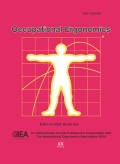Authors: Schmidtler, Jonas | Knott, Verena | Hölzel, Christin | Bengler, Klaus
Article Type:
Research Article
Abstract:
BACKGROUND: Social, technological, and legal changes imply new solutions to support the human worker in the industrial environment of the future. OBJECTIVE: Optimizing working conditions by adapting collaborative assistance systems in terms of human acceptance and well-being. The Institute of Ergonomics at the Technische Universität München (TUM) follows this approach with three novel technical solutions: Exoskeletons (Lifting Aid), collaborative robots (Cobot), and orthosis (Assembly Glove). METHODS: Fundamental scientific knowledge in cognition, anthropometrics, biomechanics, and physiology provide the basis for user-oriented designs and investigations via respiratory analysis, motion tracking, force measuring, and simulation. CONCLUSIONS:
…The human, with its abilities, flexibility, and knowledge, will still be the key success factor in future working environments. Hence holistic approaches that support the human in a complementary way to raise overall performance have to be evolved to handle upcoming challenges like demographic change, a diverse workforce, and high stress jobs.
Show more
Keywords: Human Centered Assistance Applications, exoskeleton, collaborative robot, Cobot, orthosis, Human-Robot Interaction, Human-Robot Collaboration, factory of the future
DOI: 10.3233/OER-150226
Citation: Occupational Ergonomics,
vol. 12, no. 3, pp. 83-95, 2015
Price: EUR 27.50





